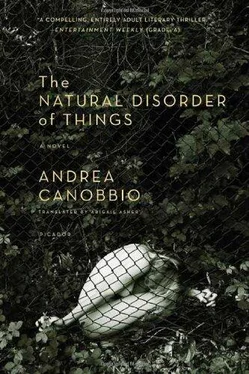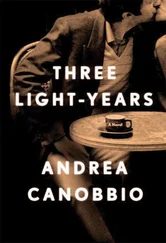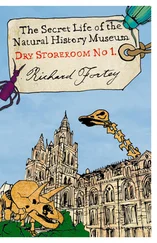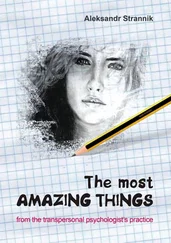And as if by magic, as if they’d survived the bombing of their embassy in Belgrade, ten Chinese men filed silently past the illuminated living room display; their hands were thrust into their pockets, and looped around their wrists were plastic bags holding soda cans and sandwiches. It was an important coincidence — or maybe not, maybe it was a normal event. But it wasn’t totally normal: ten minutes later another ten Chinese came by, just like the others, with the same weary and determined expressions. I tried to follow a news item about Mallory’s corpse, which had been found on Mount Everest, and to spin a fantasy about the rock-hard cadaver marooned up there, in a snowy armchair, looking peacefully down on the world. But I was too distracted. And when the third platoon of Chinese went by, I gave up on the newspaper, got out of the E270, and followed them.
Strange sidewalks spring up wherever a stretch of no-man’s-land suddenly tries to redeem itself and turn user-friendly, like certain computer systems. The sidewalks flank the buildings and run along the streets and generally make a show of being functional, but they really can’t hope to, because they’re useless. No one walks on them: around here a car can always drive up to within five yards of its destination, and there’s always ample parking.
But here were people using the sidewalks: the Chinese (though they were using them at night). Where were they going? Parked in front of the Shoe Warehouse, a hundred yards beyond the Blue Dahlia, three Nissan vans were waiting to take them to work somewhere. The condensed vapor on the vans’ windows shone beneath the streetlights, and the pale faces behind the clouded windows looked like hooded paper masks against the headrests. I thought I would return to the Blue Dahlia the back way, passing behind the stage set of shops and clubs facing the main road. But it was too dark, and the terrain was strewn with garbage and pieces of rotted wood and rusty metal, so as soon as I could I slipped between two buildings to get back to the light. And halfway up the shadowy alley I tripped over a leg; I didn’t understand what it was until the two guys began talking, asking me for 10,000 lire for a sandwich. I couldn’t see their faces, which merged into the wall behind them, but they both had their legs spread across the concrete, as if they were stretching. I didn’t answer; rage welling up inside, I ran off, heading into the Blue Dahlia to hide.
It was half past midnight, and just inside the red door Elisabetta Renal was retrieving her rainproof cape from the coat check, watched by the two men she’d come in with. A sort of maître d’ came toward me from the back of the bar; Elisabetta turned around, saw me, and came over to me before he did. She was agitated in her normal way, and her eyes were red, but she was cordial, even though she didn’t introduce me to her friends; one was taller than I am, with gray hair and a receding hairline; he had an imposing aquiline nose that didn’t ruin his looks, and very pale white-blue eyes that balanced out his face; he wore a dark gray suit, a dark blue tie, and a striped shirt (I couldn’t see his shoes). The other guy was short, lean, and older, and had bovine eyes and a boxer’s squashed nose; he too was impeccably dressed, in a light-colored suit and a regimental stripe tie, but he stood apart, behind the first man. We lingered inside the entrance for three or four minutes while the maître d’, smiling professionally, waited for the situation in front of his coat check station to develop one way or another (was I a chauffeur coming to pick up one of his clients?), and while Receding Hairline scrutinized me. He didn’t understand who I was or what I was doing there. Elisabetta said: “So you’re a night owl too,” and we joked a bit about insomnia and driving around at night to get rid of it. I promised her that I would be at work the next day at seven as usual, and she laid a hand on my arm, saying with a laugh that she wouldn’t notice if I was late. We both gave very convincing performances.
“You’ve got to be the most efficient and early-to-work garden designer in the whole country. Did I ever tell you that we consulted with a colleague of yours a few years back?”
“A garden designer?”
“Yes, a really odd guy — he refused to drive a car, or use any vehicle, actually, even a bike; he always walked everywhere, in these worn-out sandals. He came every morning — not at seven like you, but around noon — and spent a few hours conferring orders on his Senegalese assistant. He wanted to make a minimal garden — or at least that’s what he said. He spent most of his day traveling from one place to another, but he maintained that he came up with his ideas while walking. He was like one of those little creatures that live inside shells, at the beach … what are they called?”
“Hermit crabs,” says Receding Hairline icily.
“Right, exactly, a hermit crab. Because he carried an enormous backpack that he never put down.”
“I’ve heard about him,” I say. “His name is Astoldi, right?”
“That’s the guy. And the oddest thing is that before becoming a garden designer he was a doctor.”
“A doctor? I didn’t know that.”
“An orthopedist, I think. He said he was fed up with looking after animals, and that plants were more interesting.” She snickers.
“Why didn’t he finish the garden?”
“Well, after two weeks the Senegalese guy dumped him and found a nursing job in the city.”
Receding Hairline looks down toward his shoes and shakes his head.
Her face goes dark. “Now we really should go,” she says.
After they went out, the maître d’ stepped forward, and I asked to use the bathroom; usually the toilets are reserved for customers, but I didn’t care whether he said yes or no. Anxiety and torment showed in his eyes: I could see that years of experience had taught him to refuse, but he was trying to smother his objections. Maybe he couldn’t say no to me — apparently I was friendly with the regular customers. With a look of defeat, he directed me to a corridor lined in red: “Last door on the left.” Then he had a flash of inspiration: “Can I prepare a table for you? At this time of night we can offer a nice plate of linguine alla puttanesca …”
I admire people who really know how to do their jobs. I looked him in the eye to let him know that he had me pegged, that I would rise to his bait: “Of course, the linguine will be fine,” I murmured.
The only other time I had come to the Renals’ in the dark had been more than a month previously, the night they’d invited me to dinner. This time the scene was already different at the entry arch: two great torches were hooked to the pilasters, and three attendants, new faces, were checking the guests’ names against a list. The whole driveway was studded with torches, and before you got to the plane-tree tunnel, two other attendants had you park in a field where other guests’ cars were already slumbering beneath the starry sky. The parking area was tightly packed, and lingering between the Mercedeses and BMWs were shadowy figures in jackets and ties — chauffeurs; the occasional cigarette lighter flared up to illuminate their lips and nostrils. As I walked through the darkness, I kicked a little white terrier by mistake, and he ran off yelping. I was reminded of the story about wild dogs invading the estate; during the whole month of work we hadn’t seen any dogs, and Rossi hadn’t spoken to me about it again, but maybe he was concerned about his guests’ safety: he had an army of attendants on duty.
Anticipating that not everyone would want to make the long walk up the driveway to the villa, they had provided vehicles: a pair of funny little three-wheel cars with wicker seats for the ladies, the elderly, the lazy, and the obese. I rode in one with a middle-aged couple; we joked about riding in it, and then we traded wisecracks with two other groups who were going up on foot — the men proud of their strength, the women wobbling on their heels and regretting that they hadn’t accepted a ride. We got out by the greenhouse. The villa seemed less austere, its lines softened. Its spikiness was masked by the night and by the torch flames that cast leaping curves and spirals onto the walls.
Читать дальше












